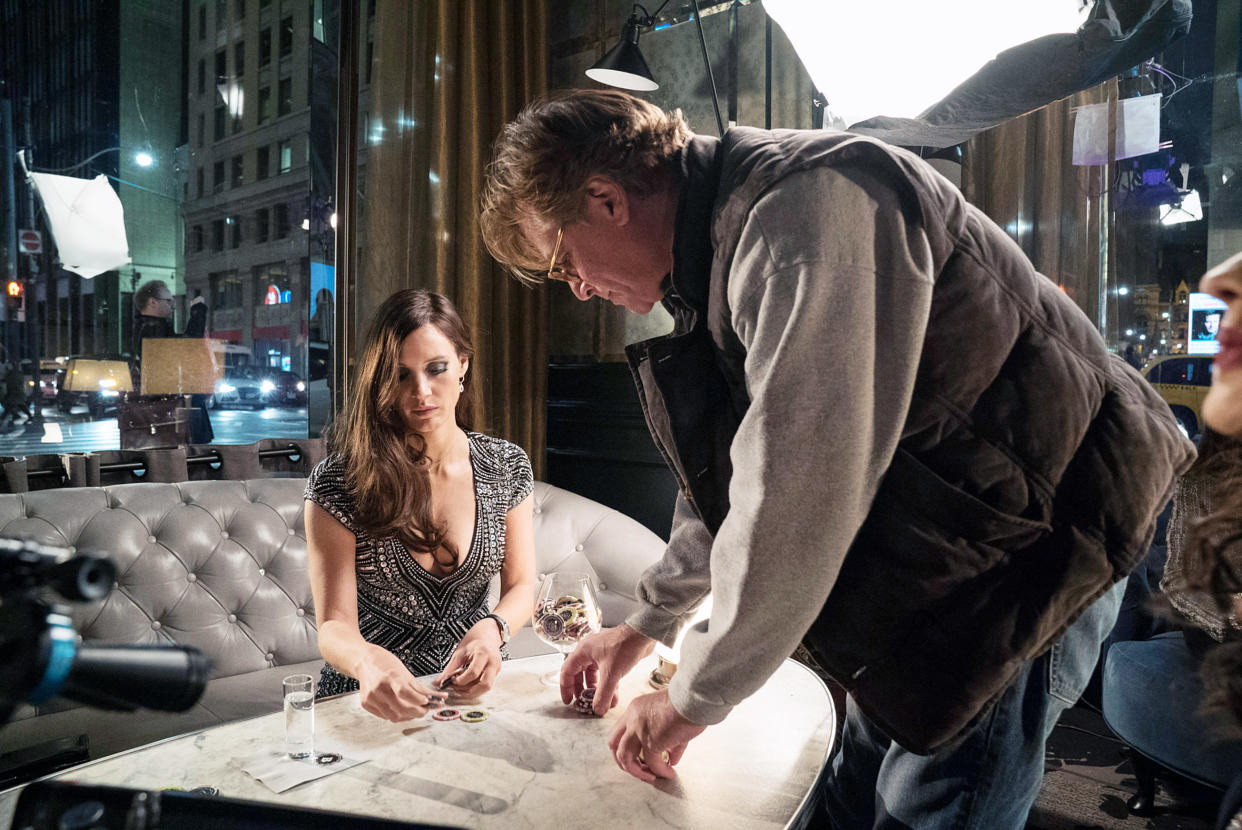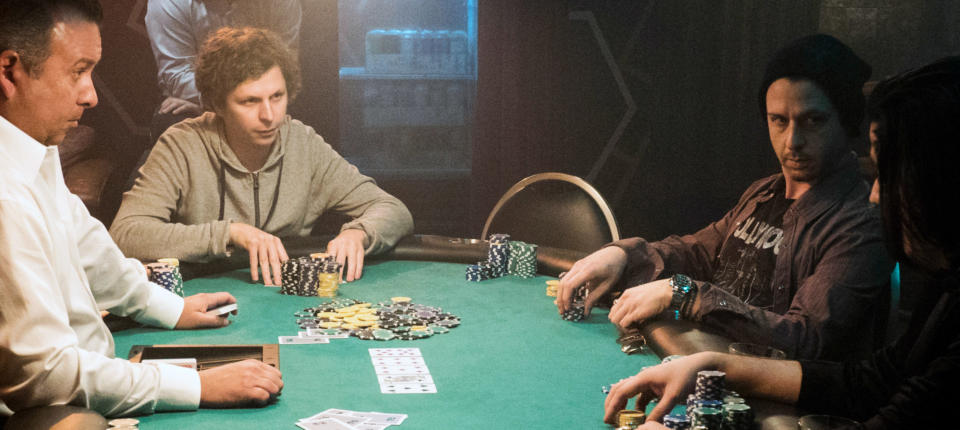Aaron Sorkin on how 'Molly's Game' presents 'a real-life movie heroine' in the #TimesUp era

If you were an actor interested in working opposite Jessica Chastain in Aaron Sorkin‘s directorial debut, Molly’s Game, you had to be ready to show up and play. Poker, that is. Adapted from the autobiography of Hollywood’s so-called “poker princess,” Molly Bloom, Molly’s Game provides an eye-opening glimpse into the high-stakes world of film industry card sharks. And Sorkin tells Yahoo Entertainment that he deliberately cast real-life poker pros as extras in order to keep the professional actors at the table even when the cameras weren’t rolling.
“Whether it was Michael Cera or Bill Camp or Chris O’Dowd, they’d all want to play poker with the pros,” Sorkin says, chuckling. “They couldn’t stop playing poker! So they almost didn’t notice when I would call action and cut. The poker was just happening; it was easy to get them to act naturally, since they were just playing poker for 14 hours a day.” The only cast member who avoided playing a hand or two was Chastain, who preferred to abide by the strict “no poker” rule that Bloom herself lived by. “She never had an easy day on the shoot,” Sorkin says of his star. “There were pages of dialogue every day, so anytime there was a break in the action, she was working on the next day’s scenes.”
The nonstop poker sessions on the Molly’s Game set weren’t just an easy way to keep the cast busy during downtime. It was also a strategic directorial decision on Sorkin’s part to make the movie’s game play seem improvised, rather than carefully choreographed, in lengthy poker sequences like the one where Camp’s character — Harlan Eustice — goes on an epic, full-tilt losing spree. The events of that scene were outlined by Sorkin on the page but had to appear entirely natural onscreen. And, for the first time in his three-decade career atop Hollywood’s screenwriter A-list, the author behind such celebrated scripts as A Few Good Men and The Social Network would be the one filming his words for the camera. “I didn’t know that I was going to be directing the movie when I was writing it,” he admits. “But I’ve always been aware that I don’t write things that are meant to be read — I write things that are meant to be performed. So I’m visualizing the movie while I’m writing it.”

Sorkin points to the movie’s tightly edited opening sequence, which depicts young Molly’s life-changing wipeout while trying to secure a place on the U.S. Winter Olympics ski squad, as an early hurdle for a first-time director to clear. “The first eight minutes of the movie has more action in it than everything else I’ve ever written combined! I also wanted to play with graphics on the screen, and cut to pieces of stock footage, like when Molly is talking about the worst things that can happen in sports and we cut to quick shots [of sports footage]. Those are the kinds of things we played with.” Sorkin also relied on insert shots and graphics to enliven the many, many poker games Bloom oversees, adding some visual dynamism to a game that’s aces to play, but often a drag to watch. “Poker is not a particularly interesting spectator sport,” he admits. “So I knew I was going to get hundreds of micro-shots of chips being slapped down, cards being shuffled, and pots being raked in. Then, in the editing room, we’d build those into exciting sequences.”
The director adopted a more traditional visual approach for quieter moments like the pivotal scene toward the end of the movie where Molly has what Sorkin describes as a “come to Jesus moment” with her father, Larry (played by Kevin Costner). It’s a sequence that Chastain herself has called “the best scene I’ve ever had the chance to do on film,” although not everyone necessarily agrees with that description. Shot almost exactly a year ago on a freezing January night in Central Park — a change of locale from the empty Los Angeles house where the real Molly and Larry had their big confrontation — Sorkin remembers ceding control of the scene to the two actors.

“With a scene like that, you don’t want to be stepping in and giving long-winded notes. You want to use as few words as possible, like, ‘A little bit faster’ or ‘A little bit hotter.’ I started with the widest possible shot to give them a chance to warm up, and then I moved in closer and closer. By the time I got to the close-ups, they were at full speed. That scene is the reason why someone like Kevin Costner takes the part: When it begins, you feel like the father is going to take the daughter in his arms and comfort her. But by the end, he collapses in her arms, and she’s comforting him. She’s the strong one.”
Sorkin’s directorial choices have certainly been received well; Molly’s Game won strong reviews when it premiered at the Toronto International Film Festival last fall, and he recently nabbed a Directors Guild of America nomination for Outstanding Directorial Achievement in a First-Time Feature Film alongside Get Out‘s Jordan Peele and Wind River‘s Taylor Sheridan. In another first, the writer made the risky choice to incorporate first-person voiceover narration into the film’s narrative, a device he’s deliberately avoided in the past. In this case, though, he felt it was essential that we hear Chastain tell Molly’s story in her own words. “I wanted it to be like the best TED Talk you’ve never been to. But I only used it for the scenes that were taking place in the past, because that’s the story she knows. The other part of the story [in the present] she doesn’t know. And we never see anything Molly doesn’t see — she’s the one telling the story, not the filmmakers.”
At the same time, there were a few instances where the filmmaker had to massage the details of Molly’s real-life story. In her book, for example, Bloom describes how a powerful actor client Tobey [widely recognized as Tobey Maguire, who is also assumed to be one of the models for Cera’s Player X in the film] offered her a sizable tip in exchange for barking like a seal. That’s a moment that Sorkin says he couldn’t recreate onscreen for both legal and narrative reasons. “I didn’t want to use any [celebrity] names at all. In a movie where your heroine is heroic because she doesn’t gossip about those people, the movie can’t gossip about them either. I also couldn’t take any identifiable moments from the book and put them in the movie. As soon as Michael Cera says, ‘Bark like a seal for a $1,000 chip,’ then Michael Cera is playing Tobey Maguire.”

Not that Molly’s Game ignores the misogyny that Bloom regularly encountered from her almost exclusively male clientele. Chastain’s Molly is offered a trip to Cabo San Lucas, Mexico, by an aggressive rock star (Justin Kirk) and alternately cajoled and threatened by both Player X and the man who introduces her to high-stakes poker, Dean Keith (Jeremy Strong). In almost each and every case, she finds a way to use their shortsighted sexism to her own advantage, remaining firmly in control of her own story — yet one more reason why Chastain’s narration is so crucial to the movie. Filmed before the revelations about Harvey Weinstein sparked the #MeToo and #TimesUp movements, Molly’s Game has taken on an added resonance since its Christmas Day release in theaters. “I would happily trade the fortuitous timing of the movie for a world where it wasn’t quite as relevant as it is now,” Sorkin says. “What attracted to me to the story in the first place is that I found Molly to be a real-life movie heroine. And now people are looking at it and seeing the story of a woman navigating a world of powerful men.”
Molly’s Game is currently playing in theaters.
Read more from Yahoo Movies:

